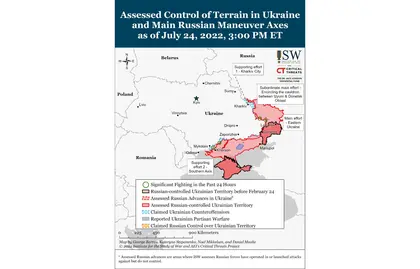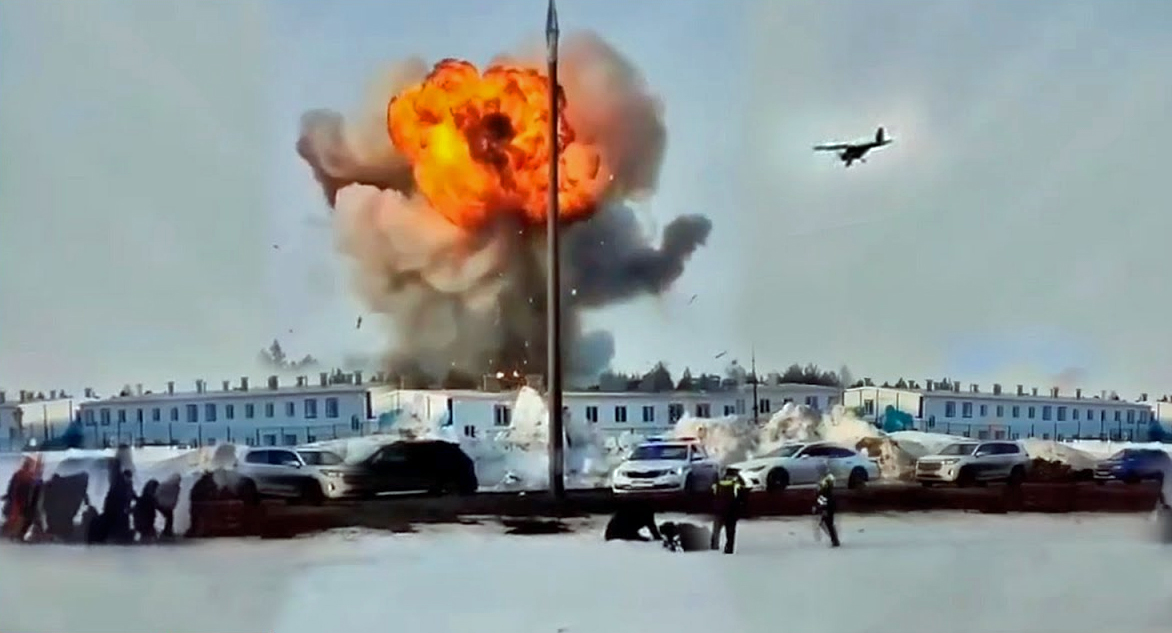Key Takeaways
- Ukrainian officials are increasingly acknowledging Ukrainian counteroffensive operations in Kherson Oblast.
- The Kremlin is facing mounting (if still very limited) domestic dissent from ethnic minorities who are disproportionately bearing the burden of the Russian war in Ukraine.
- Russian forces attempted limited ground assaults northwest of Slovyansk, east of Siversk, and south of Bakhmut on July 24.
- Ukrainian strikes have damaged all three Russian-controlled bridges leading into Kherson City within the past week.
- Russian forces attempted limited ground assaults in Kherson Oblast.
- The Kremlin continued constituting regional volunteer battalions and is leveraging private military companies’ recruitment drives to generate combat power.
- Russian occupation authorities continued setting conditions for annexation referenda in occupied territories and are recruiting Russian civilians for reconstruction efforts.
Ukrainian officials are increasingly acknowledging Ukrainian counteroffensive operations in Kherson Oblast. Kherson Oblast Administration Advisor Serhiy Khlan stated on July 24 that Ukrainian forces are undertaking unspecified counteroffensive actions in Kherson Oblast. Ukrainian President Volodymyr Zelensky said on July 23 that Ukrainian forces are advancing “step by step” in Kherson Oblast. His statement does not make clear whether he is referring to small, ongoing Ukrainian advances in Kherson Oblast or a broader counteroffensive. Ukraine’s Southern Operational Command reported on July 24 that Ukrainian forces are firing on Russian transport facilities in Kherson Oblast to impede maneuverability and logistics support. This activity is consistent with support to an active counteroffensive or conditions-setting for an upcoming counteroffensive. Khlan also said that Ukrainian strikes on Russian-controlled bridges around Kherson City only aim to prevent Russian forces from moving equipment into the city without stopping food and other essential supplies from entering the city.
JOIN US ON TELEGRAM
Follow our coverage of the war on the @Kyivpost_official.
Alarm in the Russian nationalist information space continues to grow as the pace of Russian operations slows in the face of successful Ukrainian high-mobility artillery rocket system (HIMARS) strikes on key Russian logistics and command-and-control nodes. Moscow Calling, a medium-sized Russian Telegram channel with 31,000 subscribers, posted an appraisal of the entirety of Russian operations in Ukraine since February 24. Moscow Calling defined three distinct phases of the war—the first spanning from initial invasion to the withdrawal of Russian troops from Kyiv, Sumy, and Chernihiv Oblasts and the second spanning between that point and the introduction of Western-provided HIMARS. Moscow Calling notably defined the arrival of HIMARS as a distinct turning point in the war and stated that previously provided Western weapons systems (such as NLAWs, Javelins, Stingers, and Bayraktars) did very little against Russian artillery bombardment (they are not designed or intended to counter artillery attack), but that HIMARS changed everything for Russian capabilities in Ukraine. Moscow Calling strongly insinuated that recent Ukrainian strikes on Russian warehouses, communication hubs, and rear bases are having a devastating and potentially irreversible impact on the development of future Russian offensives.

ISW Russian Offensive Campaign Assessment, December 24, 2024
This post is consistent with previous reports from Western defense officials that Russian troops are being forced to engage in various HIMARS mitigation tactics on the battlefield, including camouflage measures and constantly changing the location of equipment groupings. These mitigation tactics are impeding Russian forces from conducting the massive artillery barrages that they have widely employed over the course of the war, as evidenced by NASA Fire Information for Resource Management (FIRMS) data that shows consistently fewer observed heat anomalies over the frontline in Donbas since the introduction of HIMARS to Ukraine.
The Kremlin is likely facing mounting (if still very limited) domestic dissent from within ethnic minority enclaves, which are disproportionately bearing the brunt of the Kremlin’s force generation efforts. Vasily Matenov, founder of the “Asians of Russia” organization, stated in early July that he had officially registered the organization in order to advocate for “endangered and small-numbered peoples who are discriminated against by the Russian state.”Matenov emphasized that the preliminary goal of “Asians of Russia” is to stop the war in Ukraine due to devastating statistics on the combat deaths of soldiers from minority groups. Similarly, Advisor to Ukraine’s Minister of Internal Affairs Anton Gerashchenko cited Ukrainian sources that claim Russian authorities pay triple amounts to families of deceased soldiers from Moscow compared to families of soldiers from the minority-dominant region of Buryatia. As ISW has previously reported, protest groups in ethnic minority enclaves have already formed in Tuva and Buryatia, and these communities will likely continue to protest the Kremlin’s reliance on drawing combat power from peripheral groups of Russian society.
- Main Effort—Eastern Ukraine (comprised of one subordinate and two supporting efforts);
- Subordinate Main Effort—Encirclement of Ukrainian Troops in the Cauldron between Izyum and Donetsk and Luhansk Oblasts
- Supporting Effort 1—Kharkiv City
- Supporting Effort 2—Southern Axis
- Mobilization and Force Generation Efforts
- Activities in Russian-occupied Areas
Authors: Karolina Hird, Grace Mappes, George Barros, and Frederick W. Kagan
See the full report here.
You can also highlight the text and press Ctrl + Enter






